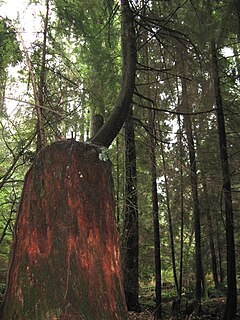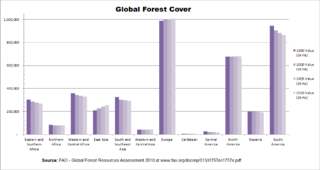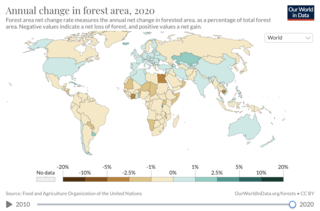Selective logging or partial forest removal is the practice of cutting down a few species of trees while leaving the rest intact and unharmed. Selective logging is often considered a better alternative to clear cutting. [1] Selective logging in the Brazilian Amazon Rainforest was recently shown in analyses of Landsat Enhanced Thematic Mapper Plus data at high spatial resolution to be occurring at rates of about 12,000–20,000 km2 per year, [2] thus indicating the central role of selective logging in tropical forest disturbance. Although selective logging has far less impact on forest processes than deforestation, selectively logged sites have higher rates of forest fires, [3] [4] tree fall, [5] changes in microclimate, [6] soil compaction and erosion, [7] among other ecological impacts on biodiversity and ecosystem functioning. [8] [9] [10]
Selective logging is a dominant form of land use in the Brazilian Amazon. Canopy gap fractions patterns are found to result from selective logging caused tree falls, roads, skid trails, and log decks, which are areas where logs are staged for transport. These gaps can vary between logging operations. Logging activities has now increased from initially low volume harvests of floodplains to much higher rates that remove around 25 million cubic metres (880×106 cu ft) of wood from the forest each year. The ecological, social, and economic impacts drive a better understanding of efficient forest management techniques and deforestation. [11] [12]
Logging in the Brazilian Amazon started when settlers came from Europe in the 17th century. Until the 1950s, logging was only allowed in floodplains around the main rivers and only in small portions. This changed as industrial mills started to populate the Amazon to produce sawn wood and veneer. These mills gained access to other areas of the Amazon through new government policies and turned selective logging into the main contributor to economic growth. This also allowed a variety of other species to be harvested in much higher volumes. This led to an abrupt advancement in the economy followed by a decline along with, high rates of deforestation, ecological damage, and a precedent of poor management practices that continue to purge the logging industry today. [11]
Three decades later timber stocks decreased and a scarcity of raw materials caused mills to mills to continuously relocate to new frontiers. Logging centers are located in the nearly all of the states of the Brazilian Amazonia. These migrations did not implement any new management techniques. [11]
Selective logging is the practice of removing only one or two tree species from a certain area. As mentioned before, selective logging is a more efficient method when compared to clear-cutting but there are still negative impacts. Selective logging in the Amazon rainforest has transitioned from low-volume harvests of one or two species to a system that can log multiple species and remain profitable. It is one of the many land uses in developing frontiers in the Amazon. However, the growth of this industry is not correlated with efficient management and better harvesting techniques. Although there are many advancements in forest management, such as reduced impact logging (RIL), they haven't been widely adopted. Several reasons as to why harmful selective logging techniques are preferred over RIL include: unclearly stated property rights, high government transaction costs, and lack of accessible information on forest management techniques. RIL also affects regeneration of trees because it creates smaller canopy gaps that restricts the natural light that regenerating trees need to survive. [13] [11] [12]
Two ways to gain permission to log forests in the Brazilian Amazon are through policy regulated forest management plans and deforestation. Nearly 15 million m3 of wood was recorded through these permissions between 2000 and 2004, but over 24 million cubic metres (850×106 cu ft) was recorded between 1998 and 2004. Much of the production from these years came from illegal logging. Illegal logging leads to governmental tax loss and poor economic advancement in logging related sectors. Additionally, illegal logging results in impoverished forests, biodiversity loss, and increased probability of fire. [6] [11]
The intensity at which all logging operations are harvesting has a direct effect on ecological advancement. Initially, forest canopy cover decreases as a result of selective logging, which leads to a slowdown of forest growth, hydrological processes, and food supply. In addition to altering forest structure, selective logging also alters the carbon cycle, and other key biogeochemical processes that help to control and maintain forest productivity. The effects of selective logging can be broken down into three major components: ground damage as a result of harvest operations, temporal patterns of canopy gap fraction within each ground damage category, and temporal changes in gap fraction resulting from felled trees. Canopy gap fraction is the integrated effect of several scale-dependent biophysical properties that provide information on canopy openness after selective logging. Trails are the biggest contributor to the ground damage, but log decks and roads were small components of the overall ground damage. However, different harvest methods and techniques result in different ground damage levels. Despite similar harvest techniques, conventional logging methods produce more ground damage than reduced impact logging. [11] [12]
Selective logging is one of the many land uses in the Brazilian Amazon, but it also increases the human access to forests through the development of a multitude of logging roads. These roads allow easier access to logging sites but also make it easier for hunters to access forest land, which reduces the biodiversity within the forest. Also, logging is most likely to occur around these roads because ease of access allows for more profit. This leads to large gap fractions[ clarification needed ] and high rates of deforestation. Inevitably, the probability of deforestation is higher for poorly managed selective logging in forest than those without.[ clarification needed ] These increases in canopy openings result in degradation and increased susceptibility to fire. Forest fragmentation is also driven as a result of high impact logging a forest. Logging in the Brazilian Amazon results in forest fragmentation as new areas of forests are produced for either clear cutting or selective logging. [11]
Almost half of the selective logging operations in the Amazon were illegal during the early 2000s. Since many of the logging practices were unregulated, high damage extraction operations rendered the forest land susceptible to drought and fire. In recently logged forests, canopy gap fractions are highest in log decks; however, the overall effect on forest gap fraction is negligible because of the deck's small surface area. [11] [12]

Deforestation or forest clearance is the removal of a forest or stand of trees from land that is then converted to non-forest use. Deforestation can involve conversion of forest land to farms, ranches, or urban use. The most concentrated deforestation occurs in tropical rainforests. About 31% of Earth's land surface is covered by forests at present. This is one-third less than the forest cover before the expansion of agriculture, a half of that loss occurring in the last century. Between 15 million to 18 million hectares of forest, an area the size of Bangladesh, are destroyed every year. On average 2,400 trees are cut down each minute.

A forest is an area of land dominated by trees. Hundreds of definitions of forest are used throughout the world, incorporating factors such as tree density, tree height, land use, legal standing, and ecological function. The United Nations' Food and Agriculture Organization (FAO) defines a forest as, "Land spanning more than 0.5 hectares with trees higher than 5 meters and a canopy cover of more than 10 percent, or trees able to reach these thresholds in situ. It does not include land that is predominantly under agricultural or urban use." Using this definition, Global Forest Resources Assessment 2020 found that forests covered 4.06 billion hectares, or approximately 31 percent of the world's land area in 2020.

The Amazon rainforest, Amazon jungle or Amazonia is a moist broadleaf tropical rainforest in the Amazon biome that covers most of the Amazon basin of South America. This basin encompasses 7,000,000 km2 (2,700,000 sq mi), of which 5,500,000 km2 (2,100,000 sq mi) are covered by the rainforest. This region includes territory belonging to nine nations and 3,344 formally acknowledged indigenous territories.

Rainforests are characterized by a closed and continuous tree canopy, moisture-dependent vegetation, the presence of epiphytes and lianas and the absence of wildfire. Rainforest can be classified as tropical rainforest or temperate rainforest, but other types have been described.

Illegal logging is the harvest, transportation, purchase or sale of timber in violation of laws. The harvesting procedure itself may be illegal, including using corrupt means to gain access to forests; extraction without permission, or from a protected area; the cutting down of protected species; or the extraction of timber in excess of agreed limits. Illegal logging is a driving force for a number of environmental issues such as deforestation, soil erosion and biodiversity loss which can drive larger scale environmental crisis such as climate change and other forms of environmental degradation.

Tropical rainforests are rainforests that occur in areas of tropical rainforest climate in which there is no dry season – all months have an average precipitation of at least 60 mm – and may also be referred to as lowland equatorial evergreen rainforest. True rainforests are typically found between 10 degrees north and south of the equator ; they are a sub-set of the tropical forest biome that occurs roughly within the 28-degree latitudes. Within the World Wildlife Fund's biome classification, tropical rainforests are a type of tropical moist broadleaf forest that also includes the more extensive seasonal tropical forests.

An old-growth forest – also termed primary forest, virgin forest, late seral forest, primeval forest or first-growth forest – is a forest that has attained great age without significant disturbance and thereby exhibits unique ecological features and might be classified as a climax community. The Food and Agriculture Organization of the United Nations defines primary forests as naturally regenerated forests of native tree species where there are no clearly visible indications of human activity and the ecological processes are not significantly disturbed. More than one-third of the world’s forests are primary forests. Old-growth features include diverse tree-related structures that provide diverse wildlife habitat that increases the biodiversity of the forested ecosystem. Virgin forests are old-growth forests that have never been logged. The concept of diverse tree structure includes multi-layered canopies and canopy gaps, greatly varying tree heights and diameters, and diverse tree species and classes and sizes of woody debris.

Clearcutting, clearfelling or clearcut logging is a forestry/logging practice in which most or all trees in an area are uniformly cut down. Along with shelterwood and seed tree harvests, it is used by foresters to create certain types of forest ecosystems and to promote select species that require an abundance of sunlight or grow in large, even-age stands. Logging companies and forest-worker unions in some countries support the practice for scientific, safety and economic reasons, while detractors consider it a form of deforestation that destroys natural habitats and contributes to climate change.

A secondary forest is a forest or woodland area which has re-grown after a timber harvest or clearing for agriculture, until a long enough period has passed so that the effects of the disturbance are no longer evident. It is distinguished from an old-growth forest, which has not recently undergone such disruption, and complex early seral forest, as well as third-growth forests that result from harvest in second growth forests. Secondary forest regrowing after timber harvest differs from forest regrowing after natural disturbances such as fire, insect infestation, or windthrow because the dead trees remain to provide nutrients, structure, and water retention after natural disturbances. However, often after natural disturbance the timber is harvested and removed from the system, in which case the system more closely resembles secondary forest rather than seral forest.
This article is the index of forestry topics.
The following outline is provided as an overview of and guide to forestry:

Brazil once had the highest deforestation rate in the world and in 2005 still had the largest area of forest removed annually. Since 1970, over 700,000 square kilometres (270,000 sq mi) of the Amazon rainforest have been destroyed. In 2001, the Amazon was approximately 5,400,000 square kilometres (2,100,000 sq mi), which is only 87% of the Amazon's original size. According to official data, about 729,000 km² have already been deforested in the Amazon biome, which corresponds to 17% of the total. 300,000 km2 have been deforested in the last 20 years.
Environmental issues in Brazil include deforestation, illegal wildlife trade, illegal poaching, air, land degradation, and water pollution caused by mining activities, wetland degradation, pesticide use and severe oil spills, among others. As the home to approximately 13% of all known species, Brazil has one of the most diverse collections of flora and fauna on the planet. Impacts from agriculture and industrialization in the country threaten this biodiversity.

The Amazon rainforest is the largest rainforest in the world, covering an area of 6,000,000 km2. It represents over half of the planet's rainforests and comprises the largest and most biodiverse tract of tropical rainforest in the world. This region includes territory belonging to nine nations. The majority of the forest is contained within Brazil, with 60%, followed by Peru with 13%, Colombia with 10%, and with minor amounts in Venezuela, Ecuador, Bolivia, Guyana, Suriname and French Guiana.

Rates and causes of deforestation vary from region to region around the world. In 2009, 2/3 of the world's forests were located in just 10 countries: 1) Russia, 2) Brazil, 3) Canada, 4) The United States, 5) China, 6) Australia, 7) The Democratic Republic of the Congo, 8) Indonesia, 9) India, and 10) Peru.
An immense number of bird species live in the Amazon rainforest and river basin. Over 1,300 of these species are types of birds, which accounts for one-third of all bird species in the world. The diets of rainforest birds greatly differ between species, although, nuts, fruits and leaves are a common food for many birds in the Amazon. Birds migrate to the Amazon rainforest from the North or South. Amazon birds are threatened by deforestation since they primarily reside in the treetops. At its current rate of destruction, the rainforest will be gone in forty years. Human encroachment also negatively affects the habitat of many Amazonian birds. Agriculture and road clearings limits the habitable areas. Birds in the Amazon are distinguished by which layer of the rainforest they reside in. Each layer or community has unique plants, animals and ecosystems. Birds interact with other animals in their community through the food chain, competition, mating, altruism and symbiosis.

Forest restoration is defined as “actions to re-instate ecological processes, which accelerate recovery of forest structure, ecological functioning and biodiversity levels towards those typical of climax forest” i.e. the end-stage of natural forest succession. Climax forests are relatively stable ecosystems that have developed the maximum biomass, structural complexity and species diversity that are possible within the limits imposed by climate and soil and without continued disturbance from humans. Climax forest is therefore the target ecosystem, which defines the ultimate aim of forest restoration. Since climate is a major factor that determines climax forest composition, global climate change may result in changing restoration aims.

The deforestation in British Columbia has occurred at a heavy rate during periods of the past, but with new sustainable efforts and programs the rate of deforestation is decreasing in the province. In British Columbia, forests cover over 55 million hectares, which is 57.9% of British Columbia's 95 million hectares of land. The forests are mainly composed of coniferous trees, such as pines, spruces and firs.

Deforestation is a primary contributor to climate change. Land use changes, especially in the form of deforestation, are the second largest anthropogenic source of atmospheric carbon dioxide emissions, after fossil fuel combustion. Greenhouse gases are emitted during combustion of forest biomass and decomposition of remaining plant material and soil carbon. Global models and national greenhouse gas inventories give similar results for deforestation emissions. As of 2019, deforestation is responsible for about 11% of global greenhouse gas emissions. Carbon emissions from tropical deforestation are accelerating. Peatland degradation also emits GHG. Growing forests are a carbon sink with additional potential to mitigate the effects of climate change. Some of the effects of climate change, such as more wildfires, may increase deforestation. Deforestation comes in many forms: wildfire, agricultural clearcutting, livestock ranching, and logging for timber, among others. The vast majority of agricultural activity resulting in deforestation is subsidized by government tax revenue. Forests cover 31% of the land area on Earth and annually 75,700 square kilometers of the forest is lost. According to the World Resources Institute, there was a 12% increase in the loss of primary tropical forests from 2019 to 2020. Mass deforestation continues to threaten tropical forests, their biodiversity, and the ecosystem services they provide. The main area of concern of deforestation is in tropical rain forests since they are home to the majority of the planet's biodiversity.

Gregory P. Asner is an American ecologist whose global work has focused on ecosystems, conservation, and climate sciences. He has developed technology to access and analyze large amounts of data about ecosystems, including assessing carbon emissions, coral reef resilience, and biodiversity. He is the founder of the Global Airborne Observatory and the creator of Carnegie Landsat Analysis System (CLAS) and CLASlite. Since 2019, he has been the Director of Arizona State University's Center for Global Discovery and Conservation Science. He is also managing director of the Allen Coral Atlas, an online map of all the coral reefs in the world used as a reference for reef conservation.